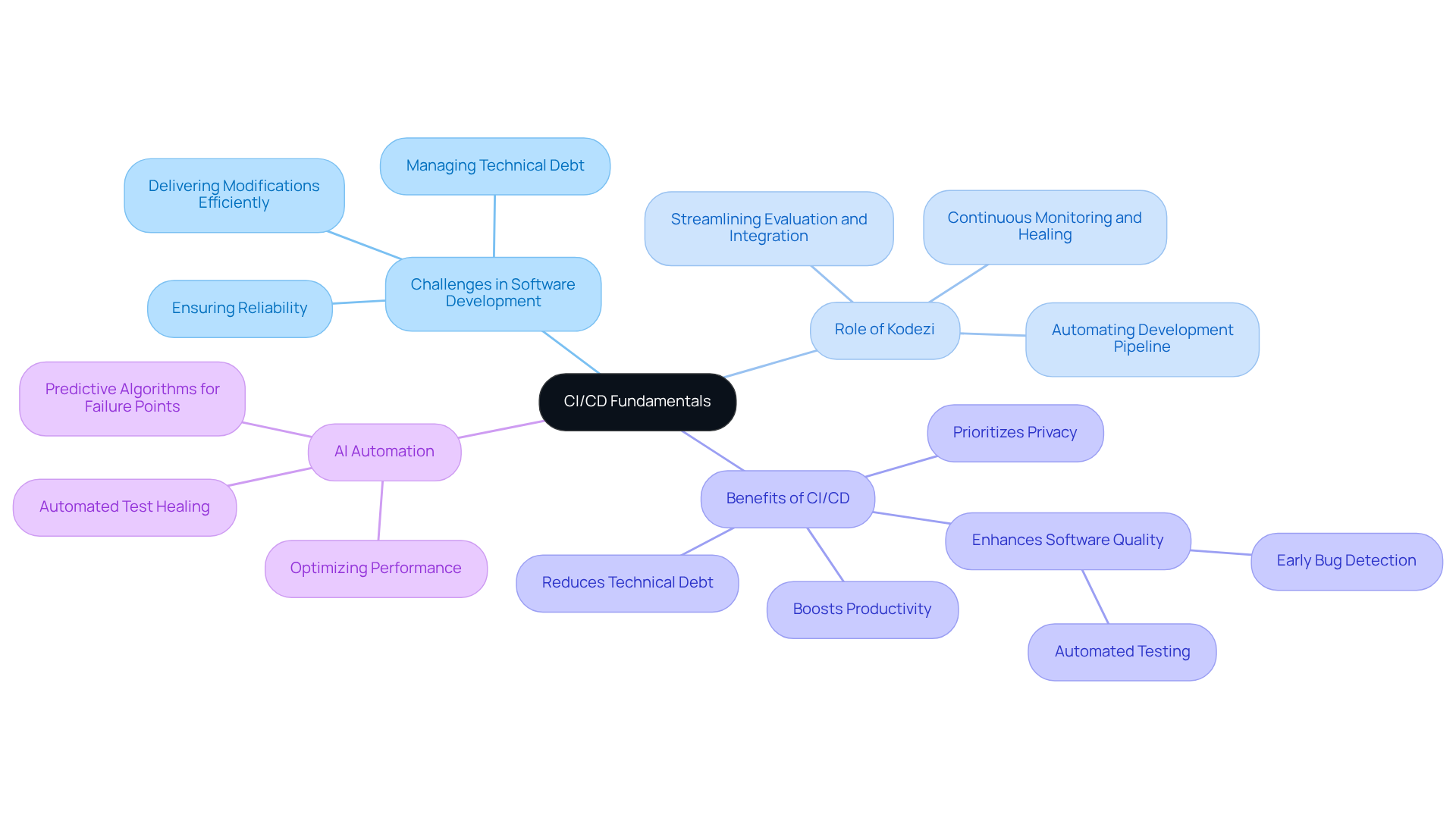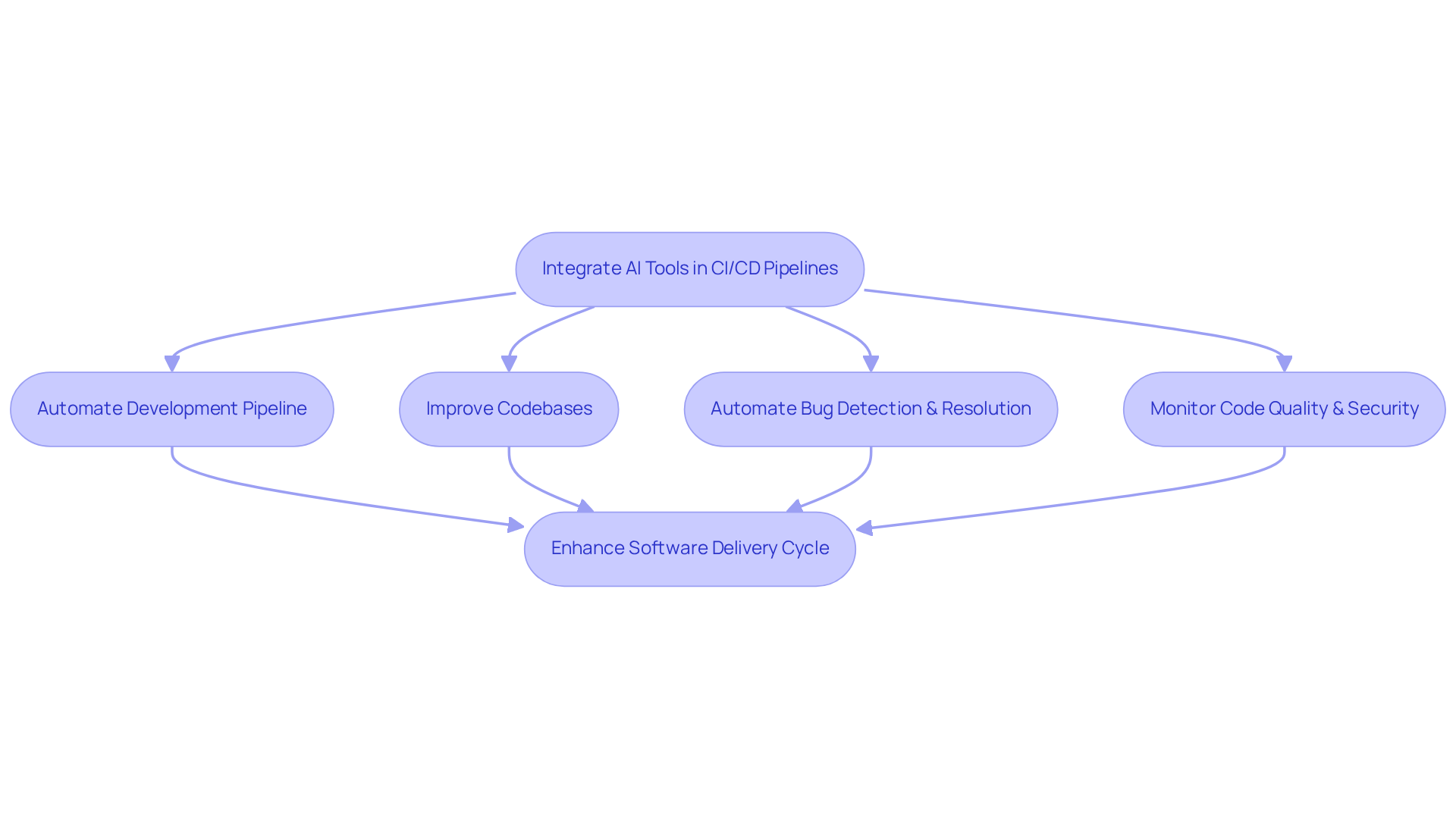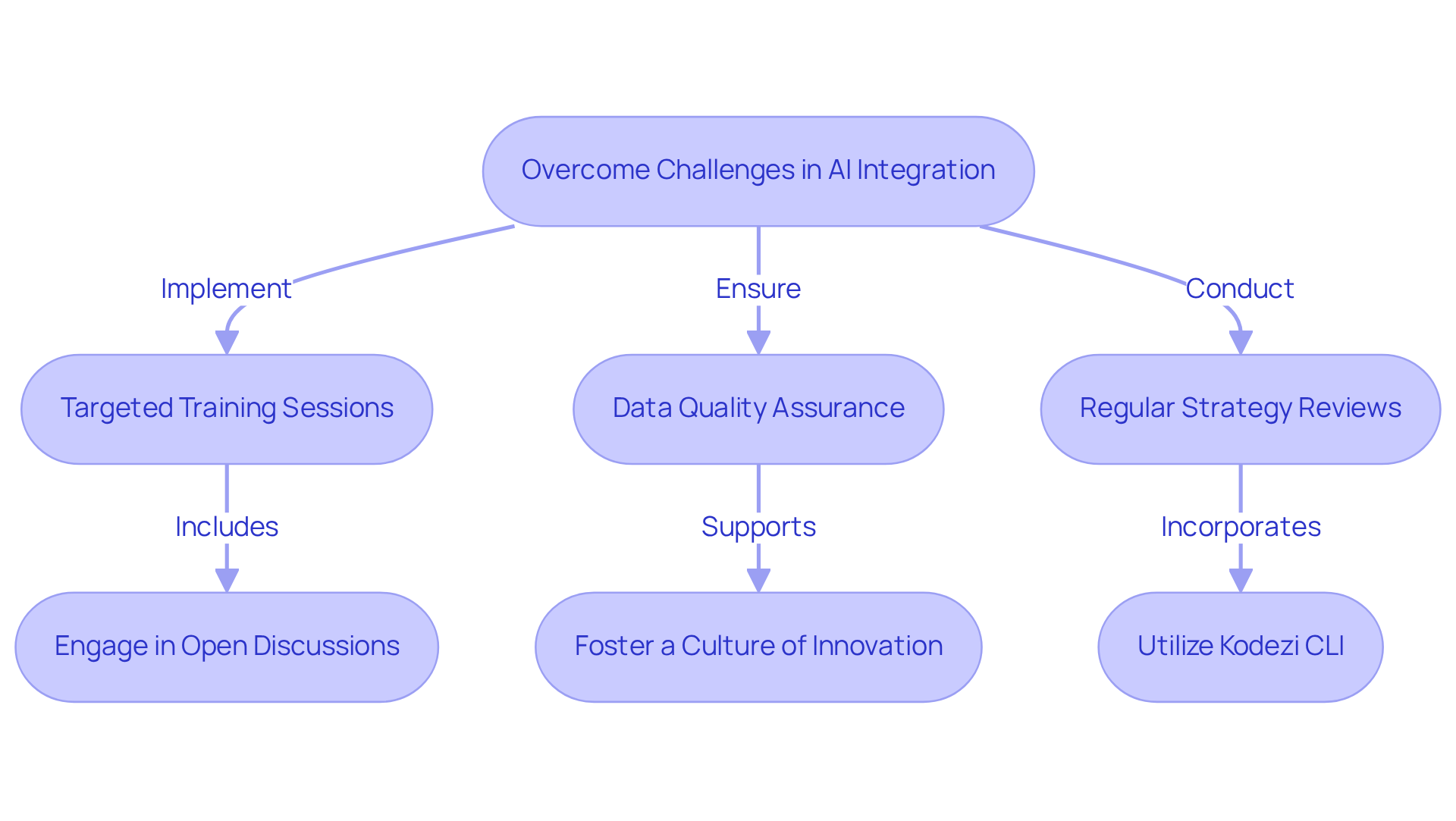Overview
Developers often face significant challenges in coding, particularly when it comes to managing complex development pipelines. These challenges can lead to inefficiencies and increased technical debt. Enter Kodezi, a tool designed to streamline this process through innovative AI solutions. By integrating Continuous Integration (CI) and Continuous Deployment (CD) practices, Kodezi addresses these coding hurdles effectively.
So, how does Kodezi enhance your development experience? Its AI-driven features automate testing and proactively resolve issues, allowing teams to focus on what truly matters: writing high-quality code. Furthermore, Kodezi not only boosts productivity but also significantly improves software quality by reducing the time spent on manual testing and debugging.
Imagine a development cycle where issues are identified and resolved before they escalate. With Kodezi, this is not just a possibility; it's a reality. The benefits are clear:
- Enhanced productivity
- Minimized technical debt
- A smoother development process
In addition, developers can enjoy the peace of mind that comes from knowing their code is being tested and validated continuously.
Are you ready to transform your coding practices? Explore the tools available on the Kodezi platform and see firsthand how they can revolutionize your development pipeline. With Kodezi, the future of coding is not just efficient; it’s intelligent.
Introduction
In the world of software development, developers often face significant coding challenges that can hinder efficiency and reliability. Continuous Integration (CI) and Continuous Deployment (CD) methodologies offer powerful solutions to these issues. Kodezi stands out by harnessing AI to automate the development pipeline, allowing organizations to streamline processes, enhance code quality, and reduce technical debt.
However, as teams implement these transformative strategies, they might encounter resistance to change and the complexities of integration. What effective strategies can be employed to not only overcome these hurdles but also unlock the full potential of AI in fostering a more agile and productive development environment?
By exploring the tools available on the Kodezi platform, teams can discover innovative features designed to boost productivity and enhance overall code quality.
Understand CI/CD Fundamentals
In the fast-paced world of software development, developers often grapple with the challenges of delivering modifications efficiently and reliably. Continuous Integration (CI) and Continuous Deployment (CD) emerge as essential solutions to these coding hurdles, especially when we leverage AI to automate the development pipeline. Kodezi addresses these challenges by streamlining the evaluation and integration of modifications into a shared repository, ensuring that these alterations are effortlessly deployed to production settings.
But why is this important? A tidy, scalable codebase is crucial, and Kodezi excels in this area. By utilizing AI-driven automated builds and testing, teams can AI automate the development pipeline with automated testers that catch bugs before they multiply, significantly enhancing software quality. Imagine instantly identifying and resolving codebase issues, optimizing performance, and ensuring security compliance—all while focusing on creating new features instead of fixing legacy problems.
The benefits of adopting CI/CD practices with Kodezi to AI automate the development pipeline are clear. This shift not only boosts productivity but also dramatically reduces technical debt, fostering a more efficient development cycle. Additionally, the platform prioritizes privacy protection, ensuring that user data remains secure. Entities implementing CI/CD practices report a 50% reduction in development and operations expenses and a 40% decline in post-release defects. Isn't it time to explore how Kodezi can transform your software development process and elevate your team's productivity?

Integrate AI Tools in CI/CD Pipelines
In today's fast-paced development environment, coding challenges can often hinder productivity. Integrating AI tools can automate the development pipeline and significantly alleviate these issues. Kodezi CLI exemplifies this by autonomously improving codebases, automating bug detection, resolution, test healing, and documentation updates. By adopting AI-driven evaluation frameworks, teams can utilize methods that automate the development pipeline to automatically create and execute assessments in response to programming changes, significantly enhancing efficiency. Have you ever wondered how much time you could save?
Startups have reported a remarkable 60-75% reduction in regression testing time when they automate the development pipeline using AI tools. Furthermore, Kodezi CLI plays a crucial role in automating the development pipeline by ensuring that code quality and security compliance are continuously monitored throughout the pipeline. This proactive approach allows developers to instantly identify and fix issues before pushing code, minimizing the risk of introducing bugs during deployment. The result? A more robust software delivery cycle.
As Andrew Ng aptly states, 'AI is the new electricity,' underscoring its transformative potential in modern software development. Additionally, Satya Nadella emphasizes that 'AI will be an integral part of solving the world's biggest problems,' highlighting the broader impact of AI in enhancing software development practices. So why not explore the tools available on the Kodezi platform and see how they can elevate your coding practices?

Overcome Challenges in AI-Driven CI/CD Integration
Incorporating AI into CI/CD pipelines often encounters significant challenges, particularly resistance to change among team members. Did you know that 66% of change initiatives fail, with employee resistance contributing to 39% of these failures? To effectively navigate these hurdles, fostering a culture of innovation within your team is essential. Engage in open discussions about the benefits of AI, emphasizing how tools like Kodezi CLI can enhance productivity and streamline workflows. Imagine never wasting time on a pull request again, as the CLI can automatically repair codebases in moments.
To further support this transition, consider the following strategies:
- Targeted Training Sessions: Familiarize team members with Kodezi CLI to alleviate anxiety and resistance; after all, 40% of employees experience anxiety during change.
- Data Quality Assurance: Ensure that the data used for AI training is clean and relevant, as poor data quality can lead to ineffective AI solutions.
- Regular Strategy Reviews: Continuously review and iterate on your AI integration strategy to adapt to evolving team needs and technological advancements, fostering a more resilient and agile development environment.
As Dr. Jeremy Pollack states, "The most successful change efforts are those that involve employees, set clear success metrics, and prioritize effective communication." By prioritizing these strategies and utilizing Kodezi CLI as a versatile tool, organizations can significantly enhance their chances of successful AI adoption and transformation, particularly as they automate development pipelines. This proactive approach ultimately helps avoid the potential loss of 6-10% of annual revenue from unsuccessful initiatives.

Implement Continuous Testing for Quality Assurance
In the fast-paced world of software development, coding challenges can often hinder progress. That's where Kodezi comes in, offering automated assessment tools that seamlessly integrate into your AI automate development pipeline. This allows tests to run with every modification, ensuring that your code remains robust and reliable.
Kodezi's AI-driven testing solutions adapt effortlessly to changes in your codebase, automatically detecting and revising unreliable tests as needed. Imagine having a flexible instrument at your disposal that enhances your team's ability to uphold quality in programming. Teams can instantly identify and fix issues with the help of tools that AI automate the development pipeline, providing detailed explanations on what went wrong and how to resolve it.
Creating a comprehensive evaluation strategy that includes:
- Unit tests
- Integration tests
- End-to-end tests
guarantees thorough coverage of your application. Are you frequently evaluating test outcomes and performance indicators? This practice is essential for identifying areas for enhancement, allowing your assessment processes to evolve alongside your codebase. This proactive approach to quality assurance not only maintains a clean and efficient codebase but also significantly reduces the likelihood of bugs in production.
With 73% of testers utilizing automation for functional and regression testing, and over 70% of test professionals using automation to quickly identify bugs, the importance of automated testing tools in maintaining code quality has never been more critical. Furthermore, the global test automation market was valued at approximately $15.87 billion in 2019 and is projected to reach $49.9 billion by 2025. Investing in these tools, particularly Kodezi's autonomous solutions, is essential for enhancing software quality assurance and leveraging AI automate development pipeline to achieve faster, more reliable development cycles.
Automated tests can increase productivity by up to 80% compared to manual processes, underscoring the efficiency gains that effective automation strategies can provide. In addition, ensuring that your codebase adheres to the latest security best practices and coding standards is vital for maintaining compliance and safeguarding your applications. Explore the tools available on the Kodezi platform and elevate your coding practices today.

Conclusion
Integrating AI into the development pipeline through CI/CD practices is not merely a trend; it represents a fundamental shift that can redefine software development efficiency and quality. By leveraging tools like Kodezi, teams can automate processes, enhance code quality, and significantly reduce technical debt—all while maintaining a focus on innovation and feature development.
The article highlights several key strategies for successful AI integration in CI/CD pipelines:
- Understanding CI/CD fundamentals
- Incorporating AI tools for automation
- Overcoming resistance to change
- Implementing continuous testing
These practices lead to improved productivity, reduced regression testing time, and a more resilient development environment. The statistics shared, including significant reductions in development costs and post-release defects, emphasize the tangible benefits of adopting these strategies.
As the software development landscape continues to evolve, embracing AI-driven automation is crucial for teams aiming to stay competitive. Organizations are encouraged to explore the capabilities of platforms like Kodezi—not only to streamline their development processes but also to foster a culture of innovation and adaptability. The future of software development lies in the effective integration of AI, and now is the time to take actionable steps toward transforming development pipelines for enhanced efficiency and quality assurance.
Frequently Asked Questions
What are Continuous Integration (CI) and Continuous Deployment (CD)?
Continuous Integration (CI) and Continuous Deployment (CD) are practices in software development that help developers deliver modifications efficiently and reliably by automating the integration and deployment processes.
How does Kodezi help with CI/CD?
Kodezi streamlines the evaluation and integration of modifications into a shared repository, ensuring that changes are effortlessly deployed to production settings while leveraging AI to automate the development pipeline.
Why is a tidy, scalable codebase important?
A tidy, scalable codebase is crucial as it allows teams to optimize performance, ensure security compliance, and focus on creating new features rather than fixing legacy problems.
What role does AI play in Kodezi's CI/CD practices?
AI-driven automated builds and testing in Kodezi help catch bugs early, significantly enhancing software quality and allowing for instant identification and resolution of codebase issues.
What are the benefits of adopting CI/CD practices with Kodezi?
Benefits include increased productivity, a dramatic reduction in technical debt, improved software quality, privacy protection for user data, and significant cost savings in development and operations.
What statistics support the effectiveness of CI/CD practices?
Entities implementing CI/CD practices report a 50% reduction in development and operations expenses and a 40% decline in post-release defects.




